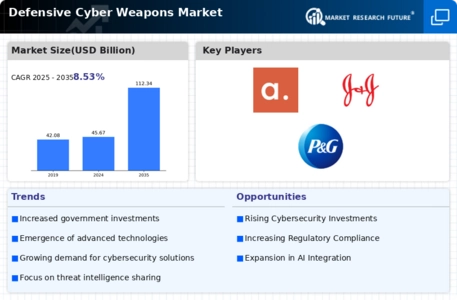Rising Cyber Threats
The increasing frequency and sophistication of cyber threats is a primary driver of the Global Defensive Cyber Weapons Market Industry. As organizations face relentless attacks from various actors, including state-sponsored groups and cybercriminals, the demand for advanced defensive measures escalates. In 2024, the market is projected to reach 45.67 USD Billion, reflecting a heightened urgency for robust cybersecurity solutions. Governments and corporations are investing heavily in technologies that can detect, prevent, and respond to cyber incidents, thereby fostering growth in this sector. The need for effective defensive cyber weapons is underscored by the potential financial and reputational damage associated with breaches.
Technological Advancements
Technological advancements play a crucial role in shaping the Global Defensive Cyber Weapons Market Industry. Innovations in artificial intelligence, machine learning, and automation are enhancing the capabilities of defensive cyber weapons, enabling faster threat detection and response. These technologies allow organizations to analyze vast amounts of data and identify vulnerabilities proactively. As a result, the market is witnessing a surge in demand for sophisticated cybersecurity solutions that can adapt to the dynamic threat landscape. The anticipated compound annual growth rate of 8.53% from 2025 to 2035 indicates a robust growth potential driven by continuous technological evolution and the need for advanced defensive measures.
Increased Investment in Cybersecurity
The surge in investment in cybersecurity by both public and private sectors is a significant driver of the Global Defensive Cyber Weapons Market Industry. Organizations are recognizing the critical importance of safeguarding their digital assets and are allocating substantial resources to enhance their cybersecurity posture. This trend is evident as companies increasingly prioritize cybersecurity in their budgets, leading to a more competitive market for defensive cyber weapons. The projected market value of 45.67 USD Billion in 2024 reflects this growing commitment. Furthermore, as cyber threats evolve, the need for innovative solutions will likely drive further investments, contributing to sustained market growth.
Government Initiatives and Regulations
Government initiatives and regulatory frameworks are significantly influencing the Global Defensive Cyber Weapons Market Industry. Countries worldwide are implementing stringent cybersecurity policies to safeguard national interests and critical infrastructure. For instance, the establishment of cybersecurity agencies and the introduction of compliance mandates compel organizations to adopt defensive cyber weapons. This regulatory environment not only drives market growth but also encourages innovation in cybersecurity technologies. As governments allocate substantial budgets for cybersecurity, the market is expected to expand, with projections indicating a growth trajectory towards 112.34 USD Billion by 2035. Such initiatives highlight the importance of a coordinated response to evolving cyber threats.
Growing Awareness of Cybersecurity Risks
Growing awareness of cybersecurity risks among businesses and consumers is propelling the Global Defensive Cyber Weapons Market Industry. As high-profile cyber incidents make headlines, organizations are becoming more cognizant of the potential repercussions of inadequate cybersecurity measures. This heightened awareness is driving demand for defensive cyber weapons that can mitigate risks and protect sensitive information. Educational initiatives and industry collaborations are further amplifying this awareness, leading to a more informed market. The increasing recognition of cybersecurity as a critical business function is expected to contribute to the market's expansion, aligning with the projected growth trajectory towards 112.34 USD Billion by 2035.

















Leave a Comment